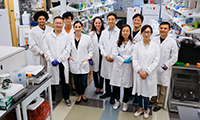Biological Pacemaker
Cardiac arrhythmia refers to irregular heartbeats, which may cause fatigue and in severe cases, unconsciousness. To correct the heartbeats, an electrical pacemaker is often implanted. Yet there are several drawbacks of the device, including battery replacement, dislodging of the lead wire, and risk of infection. The size of the device is also not suitable for pediatric patients. Patients often require invasive surgery which leads to an even higher risk of infection. Researchers have developed a device-free pacemaker, using a small molecule to convert heart muscle cells to pacemaker cells to restore natural heart rhythm and create a minimally invasive treatment for both adult and pediatric patients.
Can Stem Cells Heal the Human Heart
Cardiac Chamber-Specific Myocytes from Pluripotent Stem Cells
Every 42 seconds an American suffers from myocardial infarction, which occurs when blood flow decreases or stops in the heart damaging the heart muscle irreversibly. The cardiomyocytes, the muscles cells that make up the bulk of the heart, cannot regrow.

Human Heart
Stem cells, in principle, could provide an unlimited supply of new human cardiomyocytes. Tremendous efforts in this field has advanced this concept to demonstrating ‘human hearts in a dish', beating cardiomyocytes derived from human stem cells in a petri dish. However, critical problems have hindered these new cardiomyocytes from being translated into the clinic. The biggest problem is that these ‘human hearts in a dish' do not correctly represent the unique cardiomyocyte cell types in the heart; namely, cardiomyocytes of the ventricles, the atria and the pacemaker tissue. Serious problems may arise if atrial cardiomyocytes are introduced to damaged ventricular muscle or ventricular myocytes to damaged atrial muscle. Furthermore, "unintended delivery of pacemaker cardiomyocytes to either atrial or ventricular muscle could result in catastrophic events, disrupting the patients' natural heart rhythm", says Hee Cheol Cho, PhD, an associate professor at the Wallace H Coulter Department of Biomedical Engineering at Emory University and Georgia Tech, and Emory's Department of Pediatrics.
Until now the current practices could not delineate the three major subtypes of cardiomyocytes. Instead, random mixtures of ventricular, atrial and pacemaker cardiomyocytes are generated from the human stem cells, and it is difficult to sort them out without altering their genome or probing them invasively.

Hee Cheol Cho (sixth from left) and his team
Cho and his team have succeeded in developing a new method for deriving pools of cardiomyocytes that are enriched in ventricular, atrial or pacemaker cells. The technology takes advantage of the signaling mediated by retinoic acid, a metabolite of vitamin A, which figures prominently during development of the embryonic heart. They discovered that temporal control over the retinoic acid activity strongly influences the generation of the three types of cardiomyocytes during stem cell differentiation. With this method, the team could choose to grow cardiomyocytes enriched with atrial, left ventricular or pacemaker properties. The enriched cardiomyocytes displayed subtype-specific hallmark features in their gene expression profile and functional properties.
This new methodology not only solves a key problem in cardiac regeneration therapies but also has major implications for drug discovery. "The current in vitro platforms for cardiac drug development are largely inadequate, relying on either non-cardiac cell cultures or testing cardiac chamber-specific drugs on random mixtures of stem cell-derived cardiomyocytes. This leads to false positives/negatives and contributes to high attrition rates during drug discovery" says Cho. Raj Guddneppanavar, assistant director in the Office of Technology Transfer, working with Cho further notes that, "the pharmaceutical applications for Dr. Cho's chamber-specific cardiomyocytes is vastly important. It has the capability to improve the specificity and safety of drugs released onto the market by more accurately evaluating how they will react to specific chambers of the heart."
Moving forward, the Cho lab will be characterizing the functional properties of the de novo, chamber-specific cardiomyocytes in vitro and in animal models of human disease. The team is hopeful that their invention will become a generalizable technology for many human stem cell lines, advancing both cardiac regenerative therapies and pharmaceutical drug discovery.
Read our technology brief
Techid: 16098
View our video interview with Hee Cheol Cho.
Read Emory Medicine: Biological Pacing